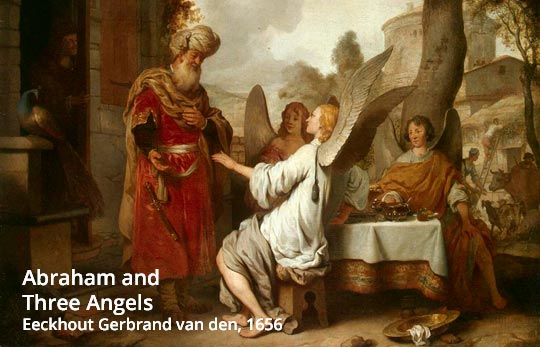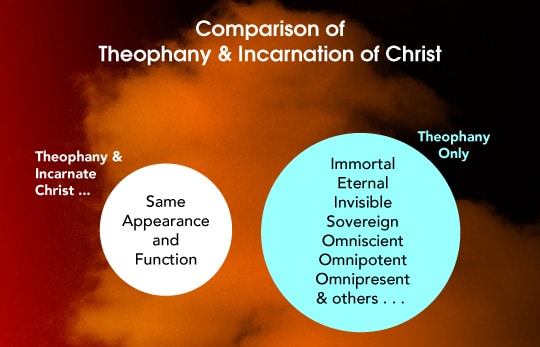Bible Question:
How were the Christophanies and incarnation of Christ different? How was an Old Testament Christophany different from the New Testament incarnation of Christ. For instance, did the physical bodies of the Old Testament Christophanies/Angelophanies have flesh and blood? Could their bodies possibly die, or did they just have a temporary appearance? I know angels could touch people and eat. Luke 20:36 says angels cannot die, but does this refer to their spirit or their physical form? How were their bodies different from the incarnation of Christ when He took on human flesh?
Bible Answer:
Our purpose is to discover the differences between the Old Testament appearances of Christ and the incarnation of Christ in the New Testament. An Old Testament appearance of Christ is called a Christophany. It may be that every theophany in the Old Testament is also a Christophany. Christ’s birth is called the incarnation of Christ. Therefore, what is the difference between a Christophany and incarnation of Christ?

Christophany and Incarnation of Christ
A Christophany is also a theophany. While there is no clear statement in the New Testament that affirms a theophany in the Old Testament was an appearance of Christ in the Old Testament, it is highly likely that Daniel 3:25 was an appearance of Christ.
Theophany or Christophany — Appears as a Man
What did people see when a theophany or a Christophany occurred? The answer is we do not know precisely what people saw as a theophany or Christophany because Scripture has not told us. The theophany in Genesis 18:1-21 provides some insight. In this passage two angels and the Lord appear in the forms of three men to Abram and Sari (Genesis 18:2). Genesis 18:13 tells us that the Lord spoke to Abram revealing that He was not just an angel but God Himself. In Genesis 18:17-21, we see more references to the Lord. Then in Genesis 18:22, we are told the other two men go to Sodom and in Genesis 19:1 we discover the two men are angels. This is an important starting point.
In Genesis 18:4-5, we are told that Abram offered to wash their feet and feed them. In verse 8 we are told that the two angels and the Lord ate the food. We can assume that Abram washed their feet. This means that both the two angels and the theophany appeared as men. They had solid bodies because their feet were washed. They had mouths and were able to eat and most likely drank liquid. They were able to sit or lie down. In short, they had taken on the physical forms or bodies of men. Throughout the passage it is clear that the Lord and the two angels communicated with Abram and Sari in human speech.
Later in Genesis 19:1-11, we discover that the men of Sodom thought they were human males. They appeared as human males. They must have been especially handsome men. Once again in Genesis 19:3, we are told that they ate food. In the following verses, they laid down. Once again, it is clear that the two angels were able to communicate.
This reminds us of Hebrews 13:2 where we are told that we can entertain angels and not know it.
Do not neglect to show hospitality to strangers, for by this some have entertained angels without knowing it. Hebrews 13:2 (NASB)
We can see, speak with, hear and even touch angels and not know it. That is, a theophany, a Christophany or an angel can appear as or like a human person. They have immortal bodies just like the resurrected body of Jesus (see discussion below).
Incarnation — Christ Is A Man and God
When Christ entered our world, He became a man. That is the statement of Luke 1:31-33. In that passage we are told that Mary would have a son and He would reign on King David’s throne. Romans 1:3-4 states that Christ was physically born as a man, but was also God. Philippians 2:6-8 also communicates the same truth. Hebrews 2:9, 14 is more detailed about Christ’ physical body. We are told Christ was made lower than the angels for a short period of time. Then verse 14 says that He had flesh and blood so that He could die on the cross.
But we do see Him who was made for a little while lower than the angels, namely, Jesus, because of the suffering of death crowned with glory and honor, so that by the grace of God He might taste death for everyone. Hebrews 2:9 (NASB)
Therefore, since the children share in flesh and blood, He Himself likewise also partook of the same, that through death He might render powerless him who had the power of death, that is, the devil . . . Hebrews 2:14 (NASB)
Hebrews 2:17 says that Christ was made like His brethren. That is, He was made like us; yet, He was also God. John 1:14 summarizes the humanity and deity of Christ when He entered this world.
And the Word became flesh, and dwelt among us, and we saw His glory, glory as of the only begotten from the Father, full of grace and truth. John 1:14 (NASB)

Christ’s Resurrected Body
Christ’s resurrected body gives us additional insight into the bodies of a theophany or a Christophany. Luke 24:13-35 and John 20:19-23 teach us that Jesus’ resurrected body could be seen. Luke 24:30-31, 36-43 adds that Jesus could eat a meal and Luke 24:31 says that He become invisible. John 20:19 and 26 reveal Jesus suddenly appeared inside of a closed room and John 20:26-29 indicates that He could be touched. Furthermore, in Luke 24:36-43 Jesus stated that He did not have a flesh and blood body nor was He a spirit.
While they were telling these things, He Himself stood in their midst and said to them, “Peace be to you.” But they were startled and frightened and thought that they were seeing a spirit. And He said to them, “Why are you troubled, and why do doubts arise in your hearts? See My hands and My feet, that it is I Myself; touch Me and see, for a spirit does not have flesh and bones as you see that I have.” And when He had said this, He showed them His hands and His feet. While they still could not believe it because of their joy and amazement, He said to them, “ Have you anything here to eat?” They gave Him a piece of a broiled fish; 43 and He took it and ate it before them. Luke 24:36-43 (NASB)
Therefore, we believe that Christ’s resurrected body was just like the bodies in a theophany or Christophany in Genesis 18:1-21.
Conclusion:
In summary, a theophany or a Christophany is different than the incarnation of Christ. A theophany or a Christophany was not like our flesh and blood—not human. Obviously, a theophany or a Christophany is immortal, eternal and can be invisible (Job 42:2; Psalm 139:7; Jeremiah 23:24; 1 Timothy 1:17). Theophanies or Christophanies were like Christ’s resurrected body.
But a human body is finite and will eventually die (Hebrews 9:27). Jesus’ human body had to die sometime. What He knew and did was performed by the power of the Holy Spirit. But Christ’s resurrected body was not the same as Jesus’ human body, which God formed in Mary’s womb as a result of the incarnation.